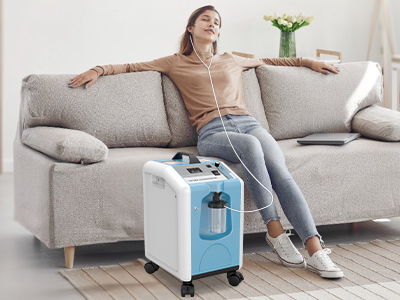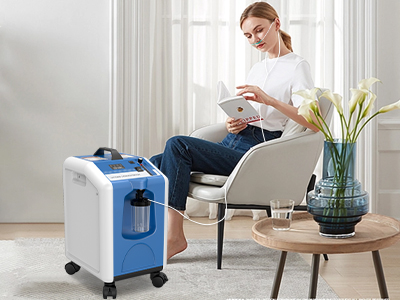07 Oct 2023
In the fast-paced realm of medical technology, where innovations are constantly reshaping the landscape of healthcare, oxygen concentrators stand as a testament to human ingenuity and the pursuit of better patient care. These devices, once bulky and limited in functionality, have undergone remarkable transformations in recent years, keeping pace with the ever-evolving needs of patients and medical professionals alike.
What Are Oxygen Concentratorst
Oxygen concentrators are medical devices that draw in ambient air, remove impurities, and deliver purified oxygen to patients with respiratory conditions. They play a vital role in ensuring that individuals with compromised lung function receive the oxygen they need to breathe comfortably.

How Oxygen Concentrators Work
These devices operate on the principle of air separation. They use filters and molecular sieves to extract oxygen from the air, increasing its concentration and delivering it via a nasal cannula or mask. This process eliminates the need for traditional oxygen cylinders.
Their Importance in Healthcare
Oxygen concentrators have become indispensable tools in the healthcare arsenal, particularly for patients with chronic obstructive pulmonary disease (COPD), pneumonia, and other respiratory disorders. Their reliability and ease of use make them a preferred choice for both in-home and clinical settings.
Recent Technological Advancements
Demystifying the oxygen concentrator
One of the most notable developments in oxygen concentrators is their size and portability. Modern units are smaller and more lightweight, enabling patients to lead active lives without being tethered to a stationary device.

Enhanced Oxygen Purity Levels
Advancements in concentrator design have led to higher oxygen purity levels, ensuring that patients receive the purest oxygen possible. This is particularly critical for those with severe respiratory conditions.
Improved Energy Efficiency
Energy-efficient concentrators not only reduce operational costs but also minimize environmental impact. They consume less power while maintaining consistent oxygen delivery.
User-Friendly Interfaces
Innovations in user interfaces make oxygen concentrators more accessible. Intuitive controls, touchscreens, and voice commands simplify operation, enhancing the overall user experience.
Eco-Friendly Oxygen Concentrators
The medical industry is increasingly focusing on sustainability, and oxygen concentrator manufacturers are no exception. Many units now adhere to eco-friendly standards, employing materials and manufacturing processes that reduce their environmental footprint.
Compliance with International Regulations
To ensure patient safety and product quality, oxygen concentrators must meet stringent international regulations and certifications. Compliance is essential for both manufacturers and end-users.
Reducing Carbon Footprints
Some concentrators are designed with energy-saving features that contribute to reducing carbon emissions. This not only benefits the environment but also aligns with global efforts to combat climate change.
Remote Monitoring and Telemedicine Integration
Remote monitoring capabilities allow healthcare providers to access real-time patient data, including oxygen saturation levels and device performance. This feature enhances patient care by enabling timely interventions.
Enhancing Patient Care from Afar
Telemedicine integration empowers medical professionals to provide consultation and guidance to patients using oxygen concentrators. This not only improves access to care but also reduces the need for frequent in-person visits.
Telemedicine Partnerships
Medical device companies are increasingly partnering with telemedicine platforms to create integrated solutions. These collaborations extend the reach of healthcare and improve patient outcomes.
Customized Oxygen Delivery
Modern oxygen concentrators offer customizable oxygen delivery modes, allowing patients and healthcare providers to tailor treatment to individual needs
Noise Reduction Technologies
Incorporation of noise reduction technologies ensures that oxygen concentrators operate quietly, promoting a peaceful environment for patients and their caregivers.
Ergonomic Design for Comfort
Patient comfort is a priority, and concentrator designs now prioritize ergonomic considerations. Lightweight and well-balanced units reduce strain on patients during use.
Collaborative Efforts in the Medical Industry
Collaboration among medical professionals, researchers, and manufacturers fuels ongoing innovation in oxygen concentrator technology. Multidisciplinary efforts drive the development of new features and capabilities.
Ergonomic Design for Comfort
Oxygen concentrator research continues to explore new frontiers, with potential breakthroughs including advanced sensors, improved oxygen delivery algorithms, and greater device connectivity.
The Future of Oxygen Concentrators
The future of oxygen concentrators looks promising, with a focus on further miniaturization, enhanced user experience, and seamless integration with telemedicine and home healthcare networks.
Conclusion
The latest developments in oxygen concentrator technology signify a commitment to better healthcare and improved quality of life for patients. These advancements, driven by ongoing research and collaboration, hold the promise of a brighter and healthier future for individuals with respiratory conditions. Staying informed about the latest trends and innovations in oxygen concentrators is crucial for medical professionals and patients alike, as it paves the way for more effective and accessible healthcare solutions.
Keywords: oxygen concentrator
Originally published 07 Oct 2023, updated 07 Oct 2023.